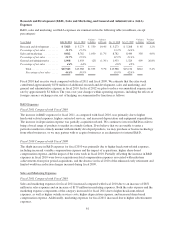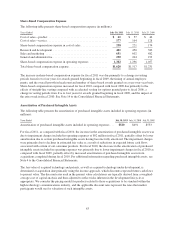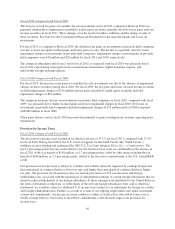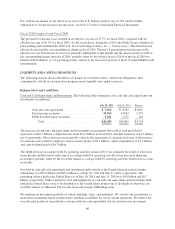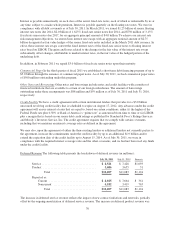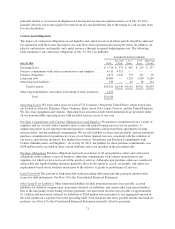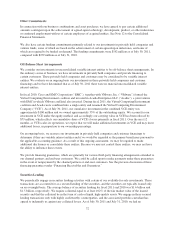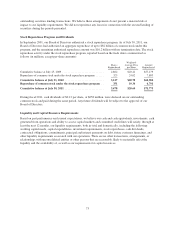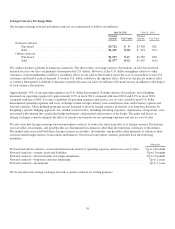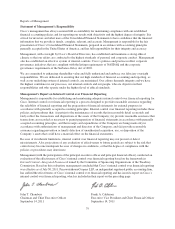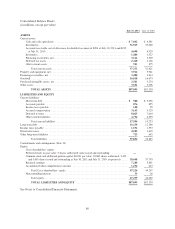Cisco 2011 Annual Report Download - page 79
Download and view the complete annual report
Please find page 79 of the 2011 Cisco annual report below. You can navigate through the pages in the report by either clicking on the pages listed below, or by using the keyword search tool below to find specific information within the annual report.
primarily related to an increase in shipments not having met revenue recognition criteria as of July 30, 2011,
partially offset by lower unrecognized revenue from two-tier distributors due to the timing of cash receipts from
two-tier distributors.
Contractual Obligations
The impact of contractual obligations on our liquidity and capital resources in future periods should be analyzed
in conjunction with the factors that impact our cash flows from operations discussed previously. In addition, we
plan for and measure our liquidity and capital resources through an annual budgeting process. The following
table summarizes our contractual obligations at July 30, 2011 (in millions):
PAYMENTS DUE BY PERIOD
July 30, 2011 Total
Less than
1 Year
1to3
Years
3to5
Years
More than
5 Years
Operating leases ............................................. $ 1,316 $ 374 $ 445 $ 220 $ 277
Purchase commitments with contract manufacturers and suppliers ...... 4,313 4,313 — — —
Purchase obligations .......................................... 2,473 1,443 779 233 18
Long-term debt .............................................. 16,000 — 3,250 3,500 9,250
Other long-term liabilities ..................................... 459 — 87 58 314
Total by period .......................................... $24,561 $6,130 $4,561 $4,011 $9,859
Other long-term liabilities (uncertainty in the timing of future payments) . . . 1,455
Total .............................................. $26,016
Operating Leases We lease office space in several U.S. locations. Outside the United States, larger leased sites
are located in Australia, Belgium, China, Germany, India, Israel, Italy, Japan, Norway, and the United Kingdom.
We also lease equipment and vehicles. Operating lease amounts include future minimum lease payments under
all our noncancelable operating leases with an initial term in excess of one year.
Purchase Commitments with Contract Manufacturers and Suppliers We purchase components from a variety of
suppliers and use several contract manufacturers to provide manufacturing services for our products. A
significant portion of our reported estimated purchase commitments arising from these agreements are firm,
noncancelable, and unconditional commitments. We record a liability for firm, noncancelable, and unconditional
purchase commitments for quantities in excess of our future demand forecasts consistent with the valuation of
our excess and obsolete inventory. See further discussion in “Inventories and Purchase Commitments with
Contract Manufacturers and Suppliers.” As of July 30, 2011, the liability for these purchase commitments was
$168 million and is recorded in other current liabilities and is not included in the preceding table.
Purchase Obligations Purchase obligations represent an estimate of all open purchase orders and contractual
obligations in the ordinary course of business, other than commitments with contract manufacturers and
suppliers, for which we have not received the goods or services. Although open purchase orders are considered
enforceable and legally binding, the terms generally allow us the option to cancel, reschedule, and adjust our
requirements based on our business needs prior to the delivery of goods or performance of services.
Long-Term Debt The amount of long-term debt in the preceding table represents the principal amount of the
respective debt instruments. See Note 10 to the Consolidated Financial Statements.
Other Long-Term Liabilities Other long-term liabilities include noncurrent income taxes payable, accrued
liabilities for deferred compensation, noncurrent deferred tax liabilities, and certain other long-term liabilities.
Due to the uncertainty in the timing of future payments, our noncurrent income taxes payable of approximately
$1.2 billion and noncurrent deferred tax liabilities of $264 million were presented as one aggregated amount in
the total column on a separate line in the preceding table. Noncurrent income taxes payable include uncertain tax
positions (see Note 15 to the Consolidated Financial Statements) partially offset by payments.
71


